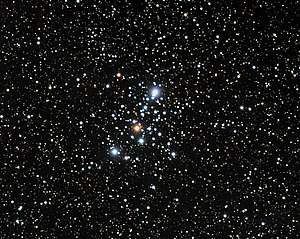M103 | NGC 581 | Open Cluster | Cassiopeia | 10,000 Light Years Away
Messier 103 is an open star cluster located in the constellation Cassiopeia. Charles Messier cataloged it in 1781, and it is situated approximately 10,000 light-years away from Earth. The cluster is notable for its distinct triangular shape, formed by a group of relatively bright stars.
With an age of around 25 million years, Messier 103 is a relatively young open cluster. The stars within the cluster share a common origin, having formed from the same molecular cloud of gas and dust. Observations of Messier 103 provide astronomers with valuable insights into the processes of star formation, the dynamics of stellar systems, and the properties of stars in various stages of their lifecycle.
Messier 103 is visible with binoculars or a small telescope, making it a popular target for amateur astronomers. The distinctive triangular arrangement of stars within the cluster adds to its visual appeal, making it an interesting and aesthetically pleasing object for sky observers. The study of open clusters like Messier 103 contributes to our understanding of the diverse population of stars in our galaxy, providing a window into the complexities of stellar birth and evolution.

